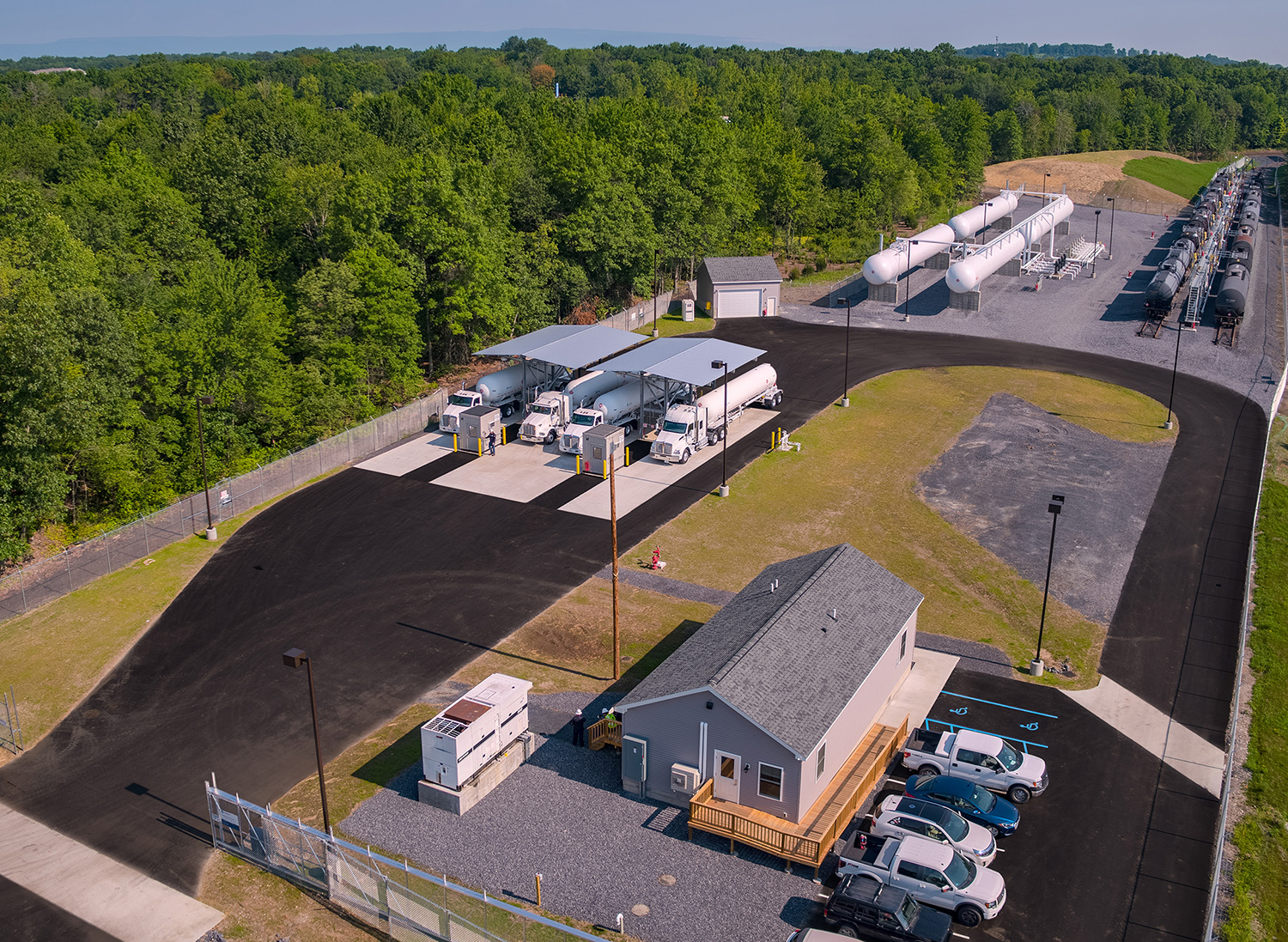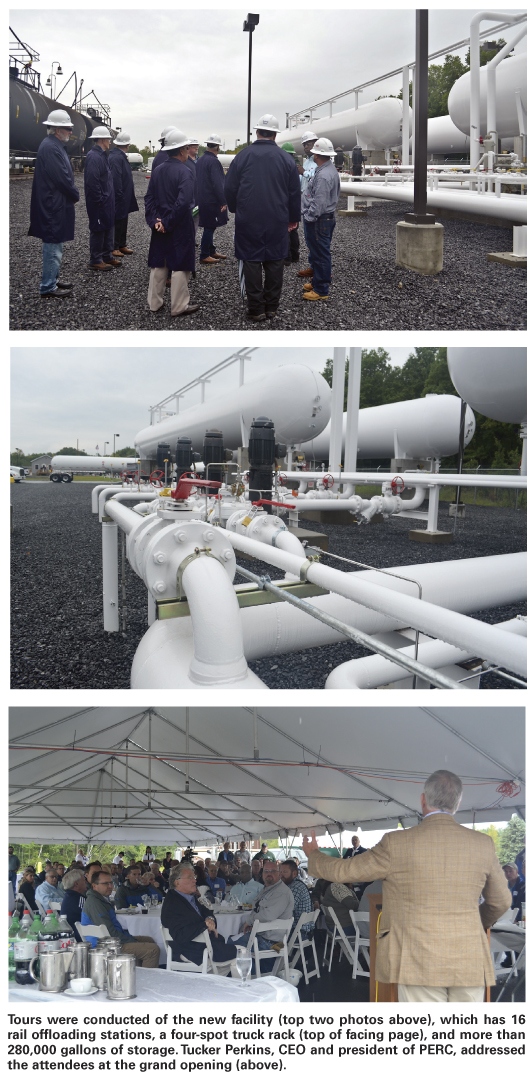
(October 2017) — RBN Energy LLC, a Houston-based consultancy contracted by the Propane Education & Research Council (PERC), recently reported on the lowest to highest supply risk areas in the U.S. The Northeast, yet again, was the highest-risk region due to its lack of refineries, only one major terminal for imports, heavy reliance on trucks and rail, and the fact that most demand is in the winter. Not surprisingly, the Gulf Coast was the lowest-risk region owing to the vast amount of storage infrastructure in the area. But the Northeast now has another source of supply. It’s online, ready for winter, and bulking up optionality and reliability.
Crestwood Services, the supply and logistics unit of Crestwood Equity Partners LP (Houston), celebrated the official grand opening of its new rail terminal in Montgomery, N.Y. Sept. 6. The terminal is now fully operational — just in time for winter. The facility, believed to be one of the largest in the United States, is providing fuel to propane marketers across New York, New England, and other areas of the Northeast.
“This new rail terminal will provide propane marketers across the Northeast with reliable supply on a year-round basis,” said Andy Ronald, vice president of supply and logistics development for Crestwood Services. “The convenient location of the terminal offers marketers greater access to product. Marketers in this region can rest easier knowing they’ll have reliable supply when they need it.”
The terminal was designed and built by Superior Energy Systems, based in Columbia Station, Ohio. The design includes 16 rail offloading stations on a continuous platform, operating two switches a day to ensure about 1 million gallons are offloaded daily. The four-spot truck rack is equipped with turbine pumps that have the capacity to load four trucks in 17 minutes, eliminating long wait times during peak winter months and optimizing daily transportation.
The 20-acre facility can store more than 280,000 gallons of propane to serve propane marketers and their customers. The Middleton and New Jersey railroads, which can operate seven days a week, serve the terminal. “Andy puts terminals into spots where there is a need,” said Derek Rimko, vice president of operations at Superior Energy Systems, who led the installation for Crestwood at Montgomery. He also led previous projects for the company in Rosehill, N.C. and Davisville, R.I.

“There are very few Montgomerys,” Ronald told BPN. “This location has a high saturation of retail marketers; rail service that can quickly bring product from key areas, including Western Canada, Chicago, and various shale projects in Ohio, Pennsylvania, and West Virginia, among others, with fairly short trip times; and the market has very consistent degree days.”
Tucker Perkins, president and CEO of the Propane Education & Research Council (PERC), joined Ronald and others at the grand opening. “This is a great day to be a champion of propane,” Perkins said in his address. “The Crestwood Services propane rail terminal here in Montgomery should help make it easier for the area’s propane marketers to serve the many families and businesses in New York and New England who rely on clean American propane.” He added that the terminal’s grand opening was a helpful reminder to propane customers to get ready for the busy home-heating season by getting their tanks filled early and working with their propane provider on a plan to stay safe and warm all winter.
Leslie Anderson, president and CEO of the Propane Gas
Association of New England (PGANE), also chairs PERC’s Supply Task Force. “We’re glad to see the terminal coming online,” Anderson said. “Any more supply options that are driving distance from New England are always a good thing.” The six states Anderson represents in the Northeast, New Hampshire, Vermont, Maine, Connecticut, Rhode Island and Massachusetts, typically have many supply challenges, particularly during cold weather spells.

“We’ve been busy getting the word out to marketers about the importance of locking in gallons this year, with tighter supply expected than in past years,” she said. “We are also making a point of contacting marketers who are not part of our association as well. After two warm winters, there is a tendency to not lock in volumes. With lower inventory, midstream suppliers setting aside less, exports strong, and the potential for a cold winter, we feel strongly this is a year to lock in a commitment for all gallons expected to be sold.” In the Northeast, Anderson has been visiting meetings of various state fuel dealer associations in order to reach propane marketers beyond her association.
Anderson and Perkins hosted a webinar with 175 industry participants in late August to emphasize concerns about this year’s supply situation. Anderson presented an overview of the situation in the U.S., stressing that the speed of exports has now more than caught up with the increased production from the shale revolution. She pointed out that, in 2015, lower values for crude caused a slowdown in production of oil, and therefore propane as well. She added, “In 2017, we may see more propane exported than being used. In the first quarter of 2017, 47% of our propane supply was exported.”
Amid the fallout from Hurricane Harvey, propane exports were slowed to less than 200,000 bbld for two weeks in a row, allowing primary U.S. inventory to move up to 82.2 MMbbl for the week ended Sept. 8, but this was still 19% lower than the previous two years. By the time reporting was in for the week ending Sept. 22, two weeks of exports of just over 1 MMbbld had drawn propane back down to 78.4 MMbbl, 24.9 MMbbl behind year-ago levels. The PERC Task Force is underscoring to marketers the importance of keeping 14 days of supply on hand, filling customer tanks early, having gas contracted with trusted suppliers with storage nearby, having the right number of bulk plants, and the right size and number of customer tanks. PERC has marketer communication resources available they can use to communicate with customers. The council is also working closely with the National Propane Gas Association (NPGA), which has produced a video outlining circumstances. It is available at www.npga.org/
NPGA Supply Recommendations. NPGA is also communicating extensively with marketers through a monthly communication and is lobbying Congress and various government agencies regarding having the Energy Information Administration incorporate exports into its days-of-supply reporting, as well as Jones Act and hours-of-service waivers, and more.
BPN asked several retail propane marketers in areas that faced some of the toughest challenges in January 2014 about their supply strategies for the approaching winter season. Tim Johnson of Propane Plus in Rehoboth, Mass. said his company has contracted nearly all the fuel anticipated to be needed for the upcoming winter. “Our six 30,000-gal. tanks are almost full at this point and we will put a load in as soon as we can until spring,” Johnson said. “We are not panicking customers, just encouraging them to keep full.” As for the new Crestwood terminal in Montgomery, Johnson said any new supply point helps in a bad situation. He’s hoping for the best.
Roland Penta of Phelps-Sungas in Geneva, N.Y., also welcomes the new Crestwood rail facility, although he has his own rail terminal. “I think the new rail facility is a tremendous asset for eastern New York and New England,” he said. “We are making no significant changes, though I have improved my throughput capacity at my rail facility.” Penta shares the concern that customers have been lulled into a false sense of security, or are complacent, after two consecutive mild winters.
Mike Hayden of Co-Alliance LLP, which has retail plants in Indiana, Michigan, and Ohio, expects grain drying demand to be twice or three times last year’s in much of his region. He’s had a limited number of retail customers install additional storage and many have been locking in volumes to protect against a winter price run-up. “Many more customers are taking advantage of fixed-price programs for protection this heating season,” he said. “We have planned for the potential tighter winter supply. Much of what we normally do is based around the potential for a tighter winter supply. We partner with reputable suppliers and transportation companies, knowing availability will certainly tighten in the winter season.”
Hayden said the shortage of January 2014 reinforced his company was doing most things right, but still had some areas to improve. “We then looked at each of our trade territories and analyzed their storage needs if product availability tightened significantly. We found, like many others that I have talked with in our industry, that we would feel more comfortable with more secured product at many of our locations.” In addition to adding storage at some of its facilities, Co-Alliance has shifted some of its contracted gallons from pipeline terminals to physical product stored in caverns. “This change to cavern storage has added a slight increase to our cost of goods, but is still less of an increase as compared to adding storage volume at our facilities,” Hayden said.
In Southern Michigan, Chris Caywood of Caywood Propane Gas Inc. has also noticed an increase in interest for crop dryer gas. “Our agriculture customers seem to need more propane for crop drying and already are exploring available pricing and supply options,” he said. “This activity is much stronger than the past few years, but it has not materialized into a significant increase in deliveries — at least yet.”
As for the overall strategy for the coming winter, Caywood said, “Broadly speaking, there are four things we are doing differently this winter. First, we are hedging differently. We have hedged a higher percentage of our price protection offering than we have in the past, shifting the mix of futures and collar contracts, and increased the number of months that these hedges are in place. Second, we have hedged our wholesale supply chain so that the wholesaler can supply propane from alternative sources if necessary. Third, we have added a new product offering to our customers that provides more flexible pre-payment options. Finally, we plan to fill our storage tanks at the plants early and often.”
Caywood agrees that many customers don’t appreciate the risk of price spikes and supply shortages this winter. “The percentage of customers with price protection remains essentially unchanged from the past few winters, and almost two-thirds of the customers who pre-paid for their propane elected a variable pricing option at a premium capped price in the event prices go down.”
In Carlinville, Ill., 75 miles northeast of St. Louis, Greg Boente of Bent-E-Gas, said, “A lot of corn is around 24% and the yield is good, so the larger farmers are going to keep shelling and drying. I look for a decent drying season if we get some cool, wet weather.” Boente said he started purchasing contracts for this season early in November 2016. “I did the same number of gallons that I normally do but I’m also doing a lot of short-term, smaller quantity contracts,” he said. “I also added 18,000 gallons of storage. I try to get customers to commit early on winter contracts to cover all the gallons, but many still wait until the fall to do contracts. Due to the mild winter, summer fills were on the light side.” —Pat Thornton

